2012 FORD SUPER DUTY transmission
[x] Cancel search: transmissionPage 2 of 93
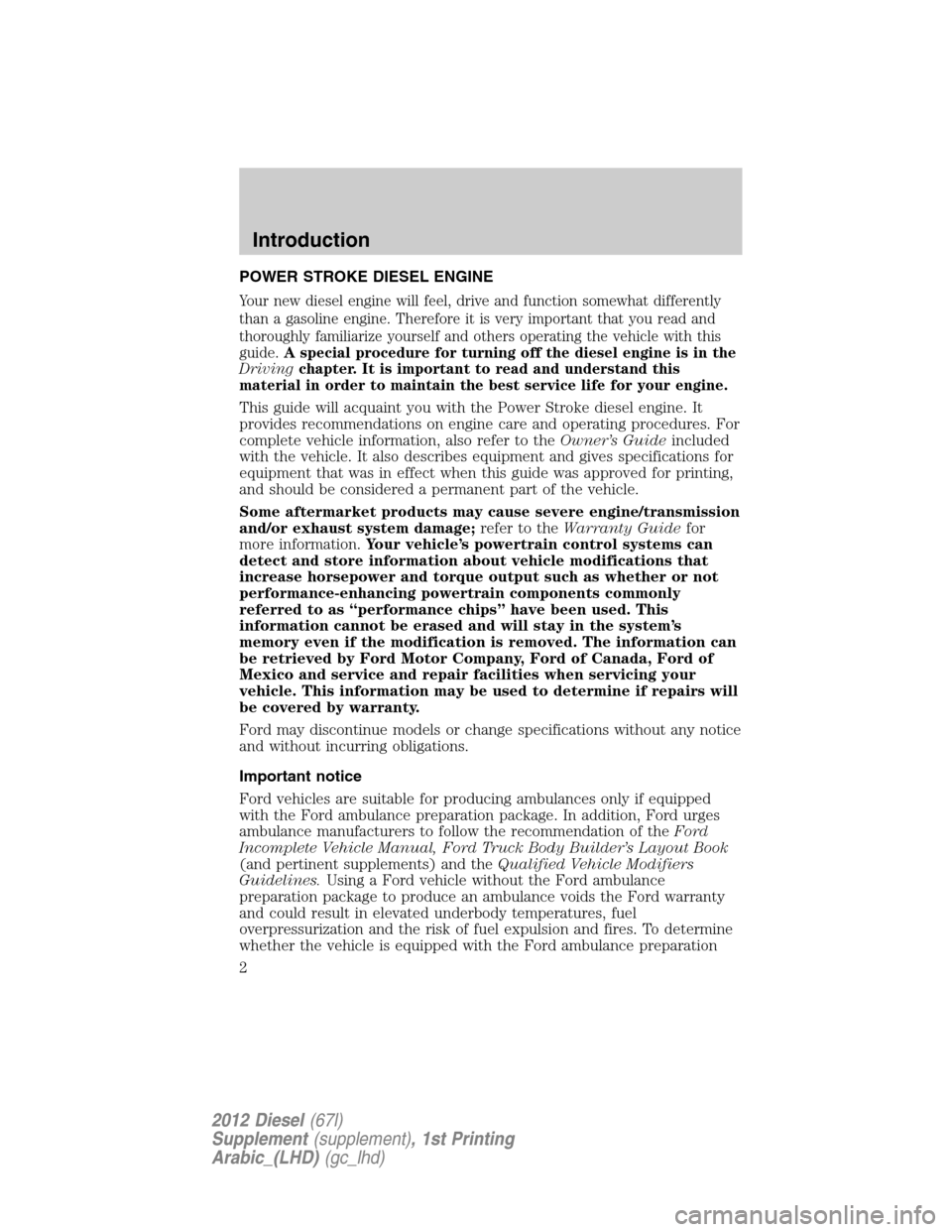
POWER STROKE DIESEL ENGINE
Your new diesel engine will feel, drive and function somewhat differently
than a gasoline engine. Therefore it is very important that you read and
thoroughly familiarize yourself and others operating the vehicle with this
guide.A special procedure for turning off the diesel engine is in the
Drivingchapter. It is important to read and understand this
material in order to maintain the best service life for your engine.
This guide will acquaint you with the Power Stroke diesel engine. It
provides recommendations on engine care and operating procedures. For
complete vehicle information, also refer to theOwner’s Guideincluded
with the vehicle. It also describes equipment and gives specifications for
equipment that was in effect when this guide was approved for printing,
and should be considered a permanent part of the vehicle.
Some aftermarket products may cause severe engine/transmission
and/or exhaust system damage;refer to theWarranty Guidefor
more information.Your vehicle’s powertrain control systems can
detect and store information about vehicle modifications that
increase horsepower and torque output such as whether or not
performance-enhancing powertrain components commonly
referred to as “performance chips” have been used. This
information cannot be erased and will stay in the system’s
memory even if the modification is removed. The information can
be retrieved by Ford Motor Company, Ford of Canada, Ford of
Mexico and service and repair facilities when servicing your
vehicle. This information may be used to determine if repairs will
be covered by warranty.
Ford may discontinue models or change specifications without any notice
and without incurring obligations.
Important notice
Ford vehicles are suitable for producing ambulances only if equipped
with the Ford ambulance preparation package. In addition, Ford urges
ambulance manufacturers to follow the recommendation of theFord
Incomplete Vehicle Manual, Ford Truck Body Builder’s Layout Book
(and pertinent supplements) and theQualified Vehicle Modifiers
Guidelines.Using a Ford vehicle without the Ford ambulance
preparation package to produce an ambulance voids the Ford warranty
and could result in elevated underbody temperatures, fuel
overpressurization and the risk of fuel expulsion and fires. To determine
whether the vehicle is equipped with the Ford ambulance preparation
Introduction
2
2012 Diesel(67l)
Supplement(supplement), 1st Printing
Arabic_(LHD)(gc_lhd)
Page 5 of 93

The glow plug system is
electronically controlled by the PCM
and GPCM. The GPCM energizes the
glow plugs immediately after the
ignition is turned on and kept on as determined by the GPCM using the
ECT, BARO and environmental temperature sensor. The required time
for the glow plugs to be energized decreases as the coolant temperature,
barometric pressure and environmental temperature increase.
Engine and secondary cooling system
The cooling system contains an engine cooling loop to cool the engine
and a secondary cooling loop to cool the transmission, exhaust gas
recirculation (EGR), charge air and fuel. The coolant serves three
primary purposes: to provide heat transfer, freeze point protection, and
corrosion protection using additives.
Vehicles with diesel engines typically are used to carry heavy loads and
accumulate mileage rapidly. These two factors may cause the additives in
the coolant to “wear out” in a shorter time. Refer to theSpecial
operating conditionssection for more information about coolant
additives and coolant change intervals. Operating the engine with
insufficient coolant and/or coolant additive can cause severe engine
damage.
Selective catalytic reduction (SCR) system
Your vehicle is equipped with a selective catalytic reduction (SCR)
system to help reduce emission levels of oxides of nitrogen from the
exhaust of the diesel engine. This system relies on the use of diesel
exhaust fluid (DEF) which must be replenished at certain intervals.
Failure to maintain proper DEF levels or if the DEF becomes
contaminated will result in vehicle speed limitations and/or result in the
vehicle entering an idle-only mode. SeeSelective catalytic reduction
(SCR) systemin theMaintenance and Specificationschapter for more
information.
Speed control (if equipped)
If vehicle speed goes outside a predetermined range from the set speed,
the RES (Resume) function will not reset vehicle speed. Vehicle speed
will need to be reset with the SET +/- button after reaching desired
speed using accelerator pedal.
Introduction
5
2012 Diesel(67l)
Supplement(supplement), 1st Printing
Arabic_(LHD)(gc_lhd)
Page 14 of 93

Operation in standing water
Ingestion of water into the diesel engine can result in immediate and
severe damage to the engine. If driving through water, slow down to
avoid splashing water into the intake. If the engine stalls, and ingestion
of water into the engine is suspected, do not try to restart the engine.
Consult your dealer for service immediately.
Rapid heat supplemental heating system (if equipped)
The optional rapid heat feature is an electrically powered device that is
designed to provide supplemental heat during engine warm up. For
maximum effectiveness mid to low blower speed is recommended during
initial warm up. When operating in automatic mode (when equipped) the
climate control unit will determine the appropriate blower speed for
existing conditions.
Note:Additional aftermarket electrical loads operated during engine
warm up may impact the performance of the rapid heat supplemental
heater.
DUAL FUEL TANK SELECTOR CONTROL (IF EQUIPPED)
If your vehicle is equipped with dual
fuel tanks, you will have a selector
control, located to the right of the
steering wheel, which allows you to
draw fuel from either tank. Your fuel
gauge and the DTE (distance to
empty) will display the amount of
fuel in the currently selected tank.
INTEGRATED ENGINE BRAKING
This feature increases engine braking at higher engine speeds to provide
better grade descent control with less brake and transmission wear and
tear.
This feature is integrated with the tow/haul mode feature. When tow/haul
mode is switched on, the integrated engine braking feature will also be
active. For more information on tow/haul, seeAutomatic transmission
operationin theOwner Guide.
Driving
14
2012 Diesel(67l)
Supplement(supplement), 1st Printing
Arabic_(LHD)(gc_lhd)
Page 20 of 93
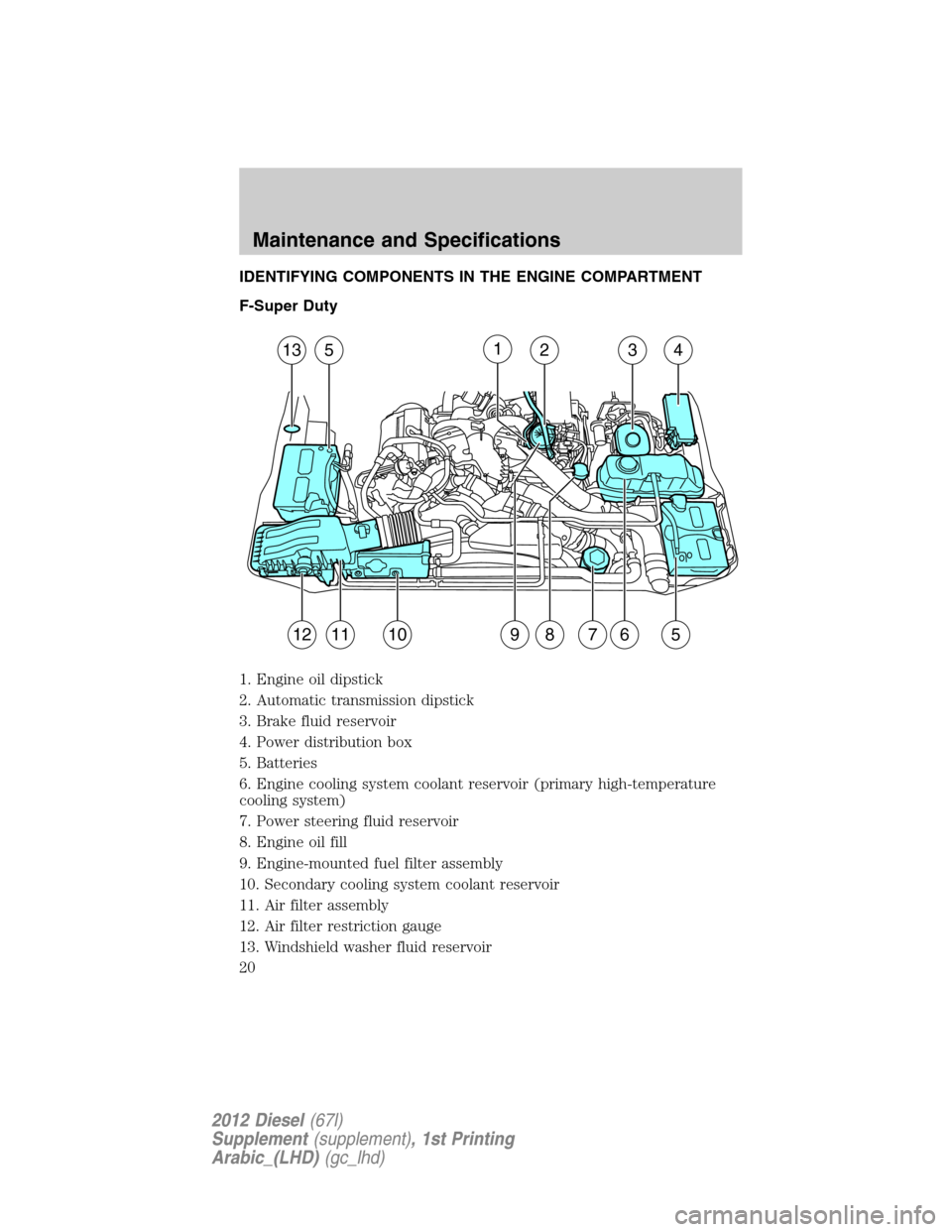
IDENTIFYING COMPONENTS IN THE ENGINE COMPARTMENT
F-Super Duty
1. Engine oil dipstick
2. Automatic transmission dipstick
3. Brake fluid reservoir
4. Power distribution box
5. Batteries
6. Engine cooling system coolant reservoir (primary high-temperature
cooling system)
7. Power steering fluid reservoir
8. Engine oil fill
9. Engine-mounted fuel filter assembly
10. Secondary cooling system coolant reservoir
11. Air filter assembly
12. Air filter restriction gauge
13. Windshield washer fluid reservoir
1135234
57691012118
Maintenance and Specifications
20
2012 Diesel(67l)
Supplement(supplement), 1st Printing
Arabic_(LHD)(gc_lhd)
Page 37 of 93
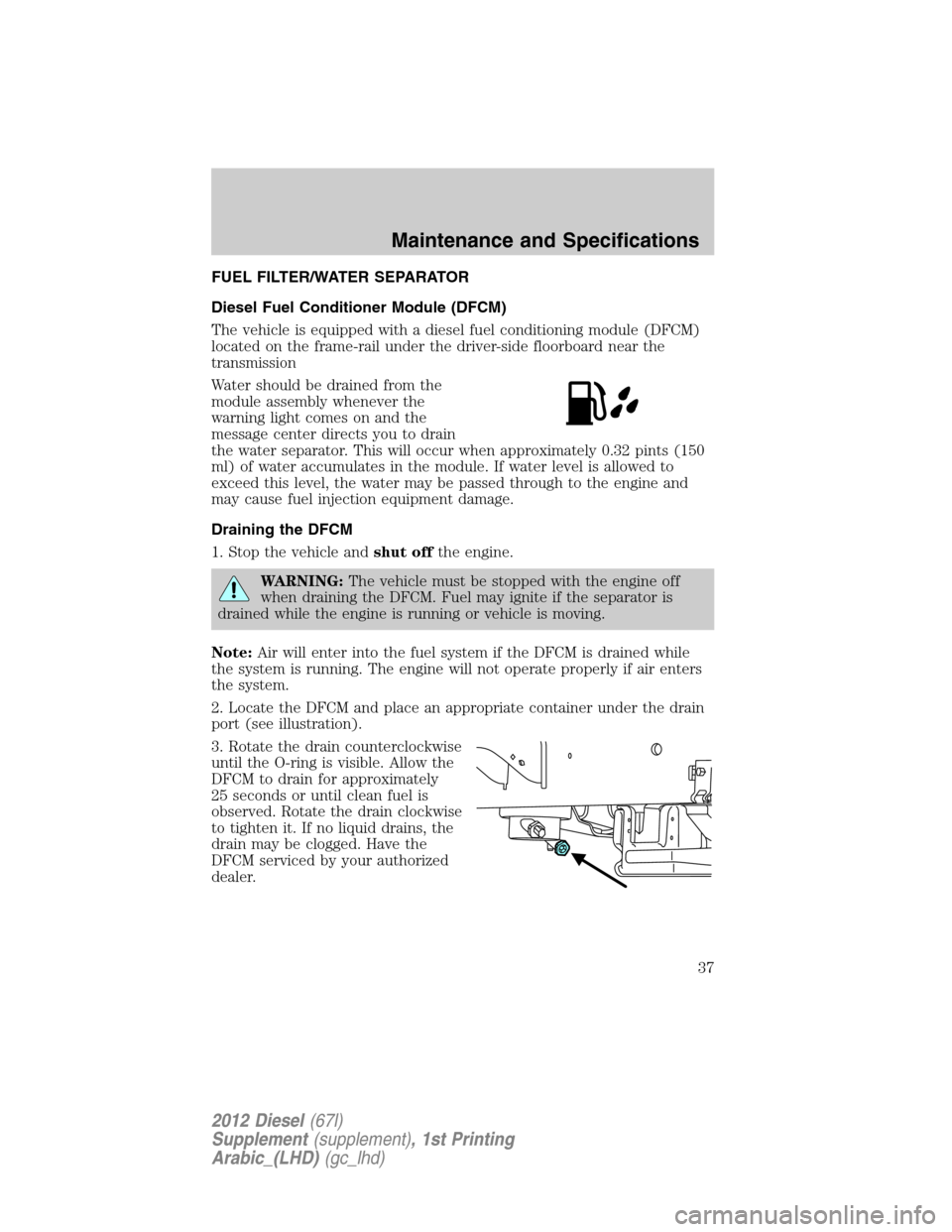
FUEL FILTER/WATER SEPARATOR
Diesel Fuel Conditioner Module (DFCM)
The vehicle is equipped with a diesel fuel conditioning module (DFCM)
located on the frame-rail under the driver-side floorboard near the
transmission
Water should be drained from the
module assembly whenever the
warning light comes on and the
message center directs you to drain
the water separator. This will occur when approximately 0.32 pints (150
ml) of water accumulates in the module. If water level is allowed to
exceed this level, the water may be passed through to the engine and
may cause fuel injection equipment damage.
Draining the DFCM
1. Stop the vehicle andshut offthe engine.
WARNING:The vehicle must be stopped with the engine off
when draining the DFCM. Fuel may ignite if the separator is
drained while the engine is running or vehicle is moving.
Note:Air will enter into the fuel system if the DFCM is drained while
the system is running. The engine will not operate properly if air enters
the system.
2. Locate the DFCM and place an appropriate container under the drain
port (see illustration).
3. Rotate the drain counterclockwise
until the O-ring is visible. Allow the
DFCM to drain for approximately
25 seconds or until clean fuel is
observed. Rotate the drain clockwise
to tighten it. If no liquid drains, the
drain may be clogged. Have the
DFCM serviced by your authorized
dealer.
Maintenance and Specifications
37
2012 Diesel(67l)
Supplement(supplement), 1st Printing
Arabic_(LHD)(gc_lhd)
Page 39 of 93
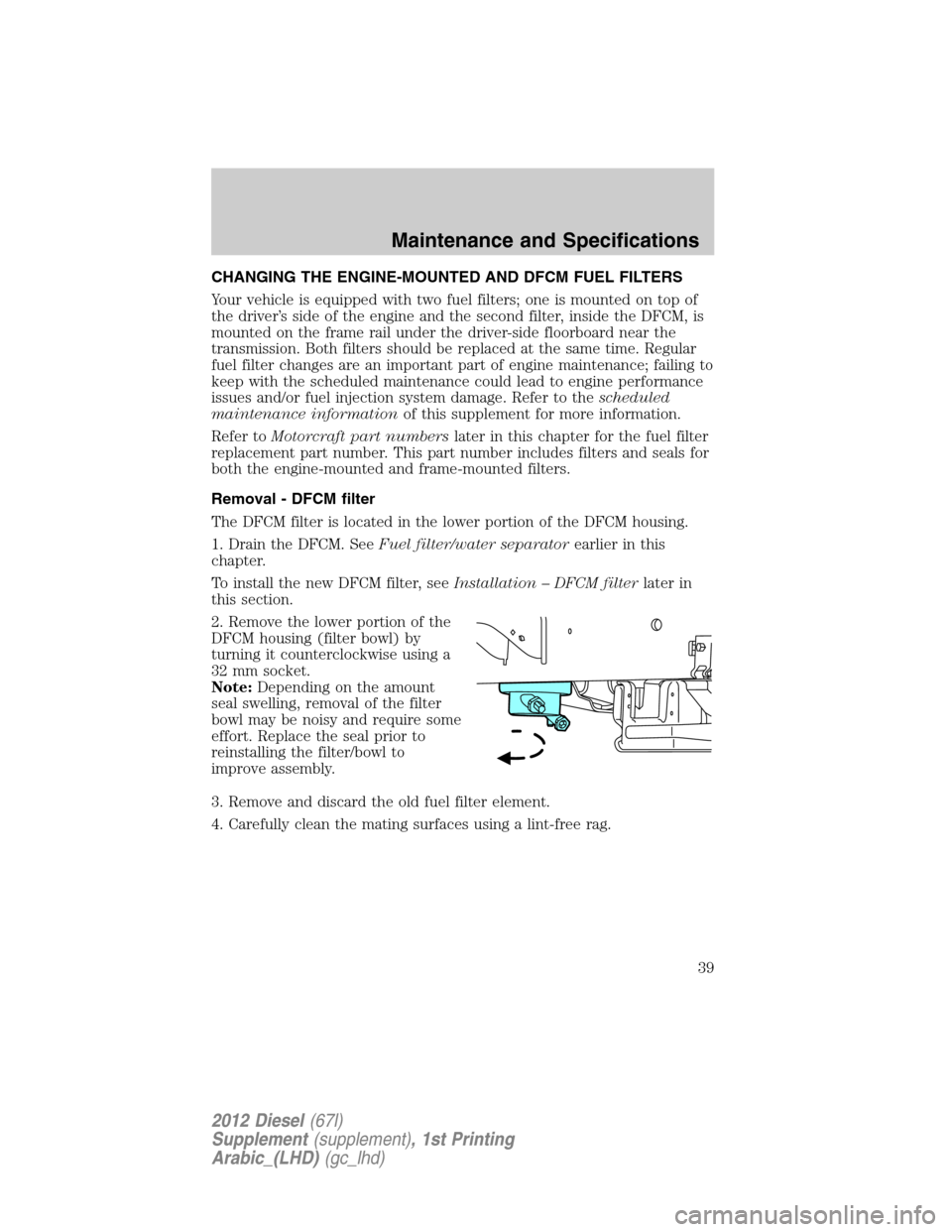
CHANGING THE ENGINE-MOUNTED AND DFCM FUEL FILTERS
Your vehicle is equipped with two fuel filters; one is mounted on top of
the driver’s side of the engine and the second filter, inside the DFCM, is
mounted on the frame rail under the driver-side floorboard near the
transmission. Both filters should be replaced at the same time. Regular
fuel filter changes are an important part of engine maintenance; failing to
keep with the scheduled maintenance could lead to engine performance
issues and/or fuel injection system damage. Refer to thescheduled
maintenance informationof this supplement for more information.
Refer toMotorcraft part numberslater in this chapter for the fuel filter
replacement part number. This part number includes filters and seals for
both the engine-mounted and frame-mounted filters.
Removal - DFCM filter
The DFCM filter is located in the lower portion of the DFCM housing.
1. Drain the DFCM. SeeFuel filter/water separatorearlier in this
chapter.
To install the new DFCM filter, seeInstallation – DFCM filterlater in
this section.
2. Remove the lower portion of the
DFCM housing (filter bowl) by
turning it counterclockwise using a
32 mm socket.
Note:Depending on the amount
seal swelling, removal of the filter
bowl may be noisy and require some
effort. Replace the seal prior to
reinstalling the filter/bowl to
improve assembly.
3. Remove and discard the old fuel filter element.
4. Carefully clean the mating surfaces using a lint-free rag.
Maintenance and Specifications
39
2012 Diesel(67l)
Supplement(supplement), 1st Printing
Arabic_(LHD)(gc_lhd)
Page 67 of 93
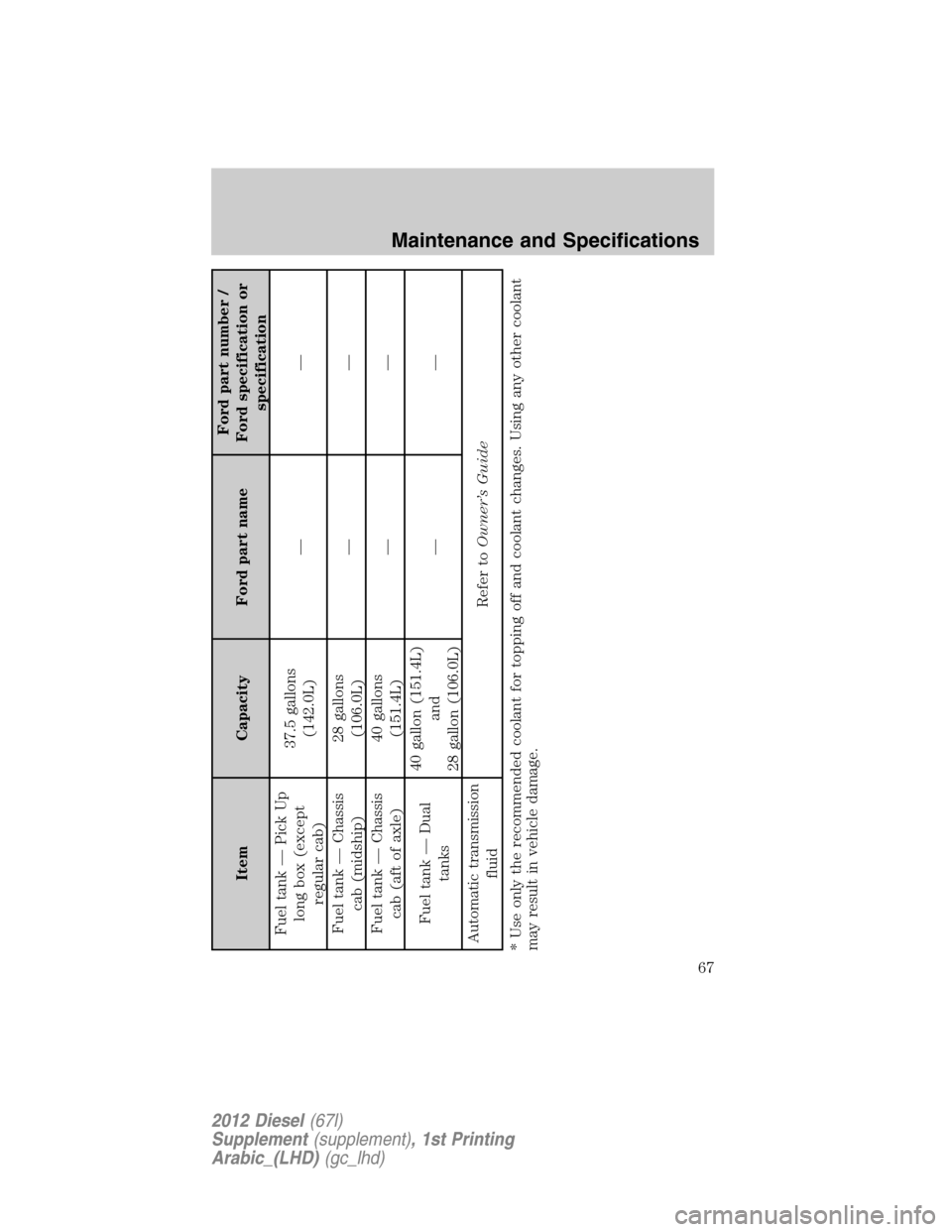
Item Capacity Ford part nameFord part number /
Ford specification or
specification
Fuel tank — Pick Up
long box (except
regular cab)37.5 gallons
(142.0L)——
Fuel tank — Chassis
cab (midship)28 gallons
(106.0L)——
Fuel tank — Chassis
cab (aft of axle)40 gallons
(151.4L)——
Fuel tank — Dual
tanks40 gallon (151.4L)
and
28 gallon (106.0L)——
Automatic transmission
fluidRefer toOwner’s Guide
* Use only the recommended coolant for topping off and coolant changes. Using any other coolant
may result in vehicle damage.
Maintenance and Specifications
67
2012 Diesel(67l)
Supplement(supplement), 1st Printing
Arabic_(LHD)(gc_lhd)
Page 72 of 93
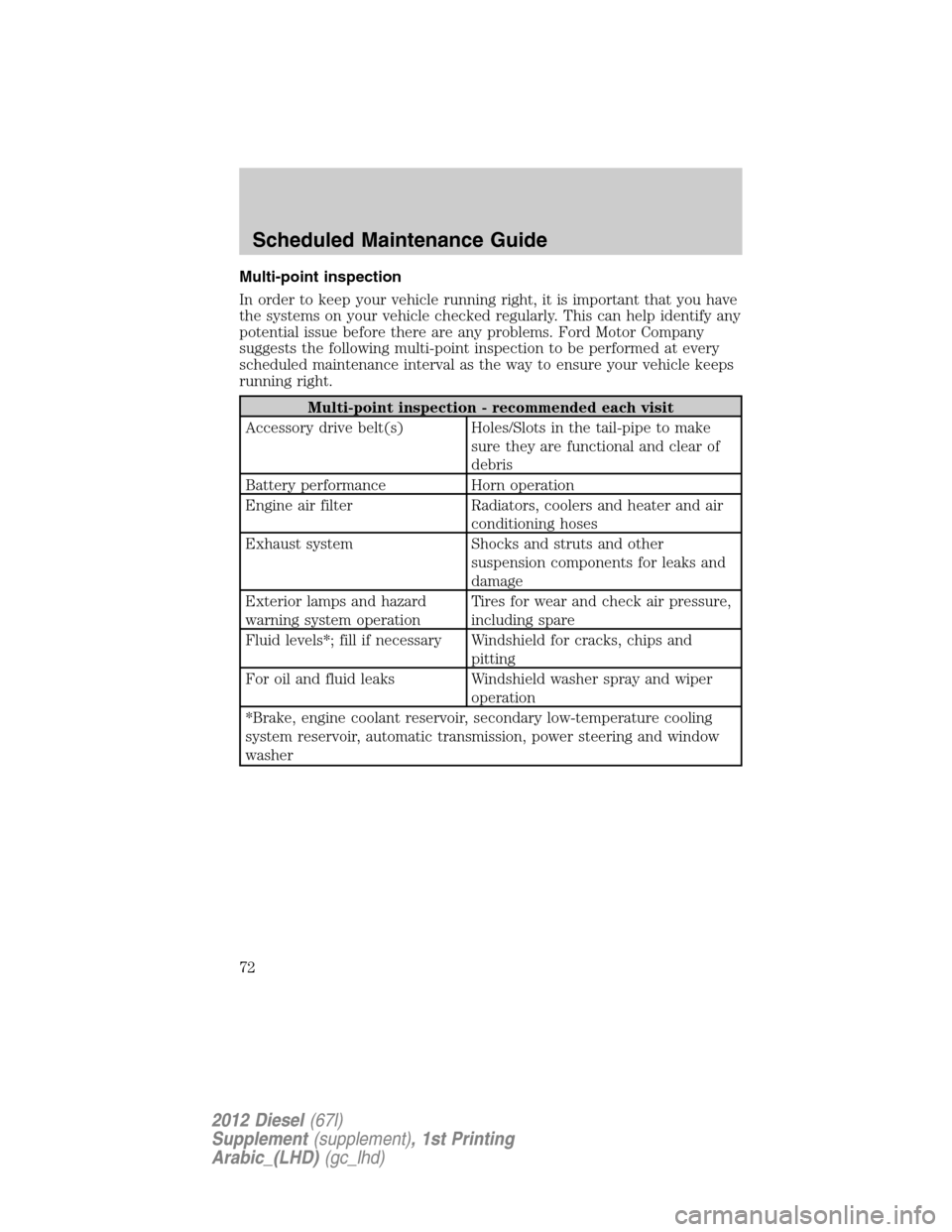
Multi-point inspection
In order to keep your vehicle running right, it is important that you have
the systems on your vehicle checked regularly. This can help identify any
potential issue before there are any problems. Ford Motor Company
suggests the following multi-point inspection to be performed at every
scheduled maintenance interval as the way to ensure your vehicle keeps
running right.
Multi-point inspection - recommended each visit
Accessory drive belt(s) Holes/Slots in the tail-pipe to make
sure they are functional and clear of
debris
Battery performance Horn operation
Engine air filter Radiators, coolers and heater and air
conditioning hoses
Exhaust system Shocks and struts and other
suspension components for leaks and
damage
Exterior lamps and hazard
warning system operationTires for wear and check air pressure,
including spare
Fluid levels*; fill if necessary Windshield for cracks, chips and
pitting
For oil and fluid leaks Windshield washer spray and wiper
operation
*Brake, engine coolant reservoir, secondary low-temperature cooling
system reservoir, automatic transmission, power steering and window
washer
Scheduled Maintenance Guide
72
2012 Diesel(67l)
Supplement(supplement), 1st Printing
Arabic_(LHD)(gc_lhd)